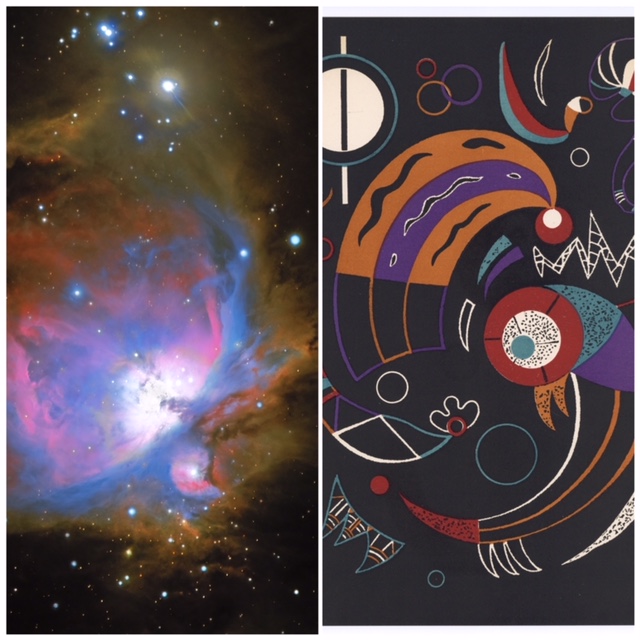Orion Nebula M42
timc
Attached is an interpretation of the Orion Nebula M42 in Orion. This cloud of gas and dust is a stellar nursery and lies close to us in our Milky Way galaxy, at approx. 1340 light years away. This must be one of the best known and most imaged objects in the sky, as it is bright and spectacular. For imaging, the major problem is dealing with the huge contrast in light and dark this target presents. This image consists of the following 45 second sub-exposures: L x 26 unbinned; B x 18; R and G x 17 binned x2 making 58.5 minutes of imaging time, taken on the nights of 12th and 13th December 2020. I used a Televue NP101 (4 inch) refractor at f/5.4 mounted on a Paramount MX using a QSI 690 CCD camera and Lodestar guide camera. Image capture was done with Maxim DL and I used CCD Stack2 and Photoshop CS5 for further processing. Thanks for looking.
Tim C
JR

Attached is an interpretation of the Orion Nebula M42 in Orion. This cloud of gas and dust is a stellar nursery and lies close to us in our Milky Way galaxy, at approx. 1340 light years away. This must be one of the best known and most imaged objects in the sky, as it is bright and spectacular. For imaging, the major problem is dealing with the huge contrast in light and dark this target presents. This image consists of the following 45 second sub-exposures: L x 26 unbinned; B x 18; R and G x 17 binned x2 making 58.5 minutes of imaging time, taken on the nights of 12th and 13th December 2020. I used a Televue NP101 (4 inch) refractor at f/5.4 mounted on a Paramount MX using a QSI 690 CCD camera and Lodestar guide camera. Image capture was done with Maxim DL and I used CCD Stack2 and Photoshop CS5 for further processing. Thanks for looking.
Tim C
--
You received this message because you are subscribed to the Google Groups "croydonastro" group.
To unsubscribe from this group and stop receiving emails from it, send an email to croydonastro...@googlegroups.com.
To view this discussion on the web visit https://groups.google.com/d/msgid/croydonastro/fb2433ed-e69e-414e-b324-a8942c83c32dn%40googlegroups.com.
<M42 Orion Nebula QSI 690 TV101 BB August 2021 Final.jpg>
tcos...@gmail.com
Thanks for your comments James. Much appreciated. I like your Kandinski image and yes, the two are remarkably similar! There are many different variations of M42 images on the web and my image was the result of less than an hour’s imaging time. From that point of view, it was not very ‘deep’. The colours came out just how they did, so I thought it would also be interesting to draw out the dusty cloud in which M42 sits. I don’t think one often sees that and to me the dust cloud being illuminated by the bright trapezium stars gives the nebula added depth and perspective, as if one is looking down a cave to the nebula beyond. Appreciate it may not be everyone’s cup of tea, but astro images are generally an interpretation of reality (to a greater or lesser degree) and by its nature, M42 must be one of the objects open to the greatest degree of interpretation!
Best wishes
Tim
To view this discussion on the web visit https://groups.google.com/d/msgid/croydonastro/7F853567-32BC-4382-A923-4D452FB2BE44%40aol.com.
William Bottaci
Most objects have such a range of brightness, resulting in high contrast, that they much benefit from treatment just for this affect, so your image is all the better for it, and a remarkable result considering the total exposure time is shorter than your usual.
For me M42 Great Nebula in Orion is the iconic deepsky object.
Thanks for sharing.
William
On Tue, 31 Aug 2021 at 09:07, <tcos...@gmail.com> wrote:
Thanks for your comments James. Much appreciated. I like your Kandinski image and yes, the two are remarkably similar! There are many different variations of M42 images on the web and my image was the result of less than an hour’s imaging time. From that point of view, it was not very ‘deep’. The colours came out just how they did, so I thought it would also be interesting to draw out the dusty cloud in which M42 sits. I don’t think one often sees that and to me the dust cloud being illuminated by the bright trapezium stars gives the nebula added depth and perspective, as if one is looking down a cave to the nebula beyond. Appreciate it may not be everyone’s cup of tea, but astro images are generally an interpretation of reality (to a greater or lesser degree) and by its nature, M42 must be one of the objects open to the greatest degree of interpretation!
Best wishes
Tim
Hi Tim
That's a great take on a familiar object. It goes well alongside Kandinski's version of Comets.
James
tcos...@gmail.com
Hi William
Thank you for your kind comments. As always, your words are thoughtful and supportive. Much appreciated.
Best wishes
Tim
--
You received this message because you are subscribed to the Google Groups "croydonastro" group.
To unsubscribe from this group and stop receiving emails from it, send an email to croydonastro...@googlegroups.com.
To view this discussion on the web visit https://groups.google.com/d/msgid/croydonastro/CAHfnR25zhk5RDpqQK_QnWZ%2BMgGjFVTut%2B67vavhWUuYuWq__vg%40mail.gmail.com.
